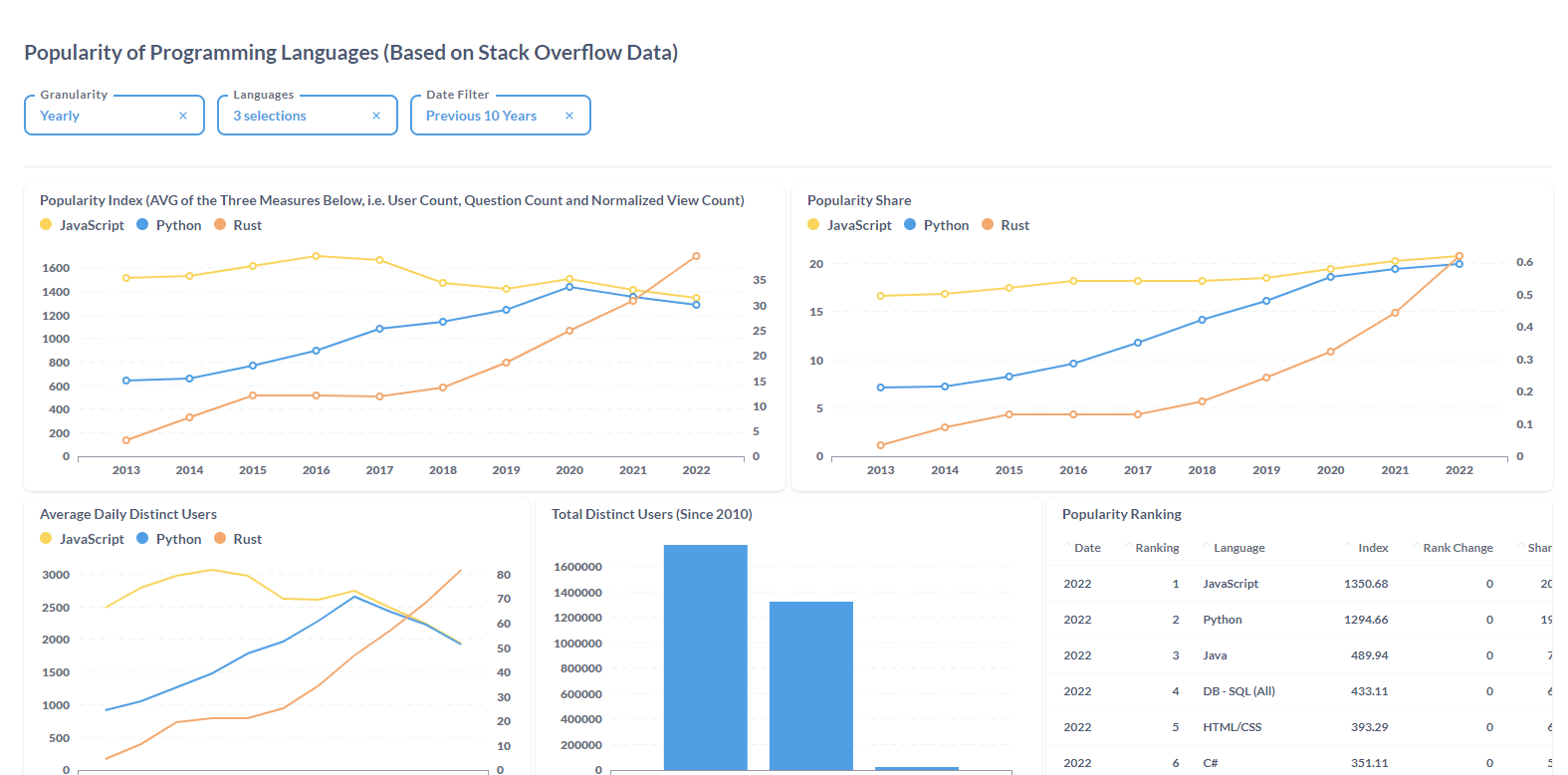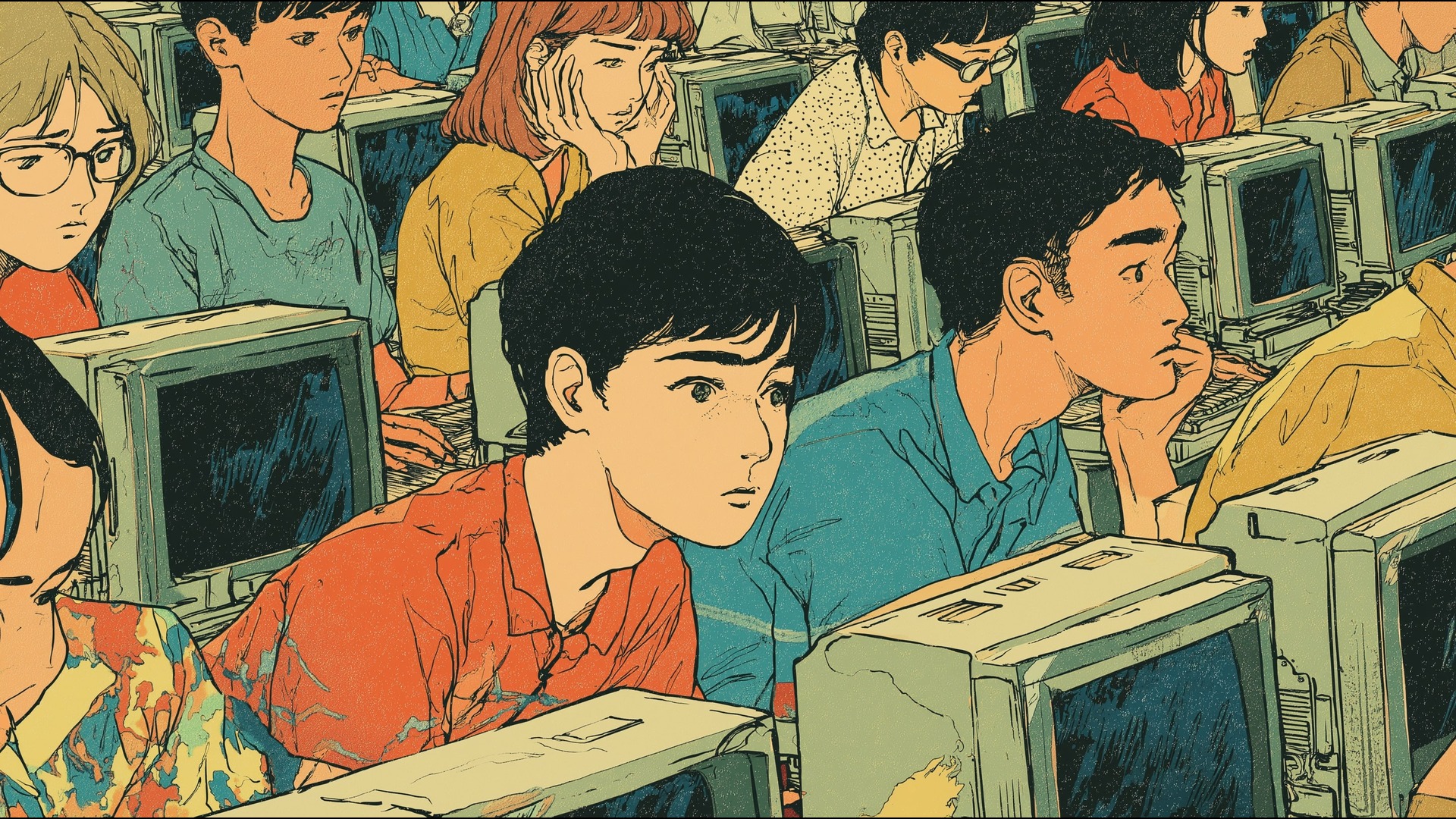Choosing the Right Programming Language: A 2024 Guide
In this article, we will look at the top programming languages that are currently in demand.
5К открытий8К показов
The modern world’s rapid technological advancement defines the course of development in nearly all sectors of the economy. This is why, in the fast-paced world of technology, selecting the right programming language is critical to success. It is even more true in 2023, as digital environments continue to evolve rapidly. In this article, we will look at the top programming languages that are currently in demand.
The Landscape of Programming Languages in 2024
The proliferation of new languages: The number of programming languages has increased in recent years, with new ones designed to solve specific problems in specific niches such as mobile app development, data analysis, or systems programming. This proliferation reflects a broader trend in the tech industry towards specialisation. While widely applicable languages such as Java and C++ remain popular, newer languages such as Go and Swift are gaining traction due to their ability to handle concurrent processes and seamlessly integrate with modern infrastructure.
The role of open-source communities: The developer communities are very important because they collaborate to advance the language, removing the constraints of a single corporate entity dictating the language’s direction. Python, for example, has thrived under an open-source model, with an extensive library of tools and frameworks developed through community contributions. The collaboration principle within these communities allows for faster adaptation to new technologies and user feedback. Furthermore, they play an important role in language standardisation processes and in providing language users with support through documentation, forums, and other collaborative platforms.
Industry Trends: Breakthroughs in specific industries usually shape the overall technological environment as well as the direction of industry growth. Artificial Intelligence (AI) and Machine Learning (ML) are at the forefront of progress in 2024, having a significant impact on virtually any industry today. Furthermore, Blockchain and cryptocurrency technologies are rapidly revolutionising the financial sector, making transactions faster and more secure than ever before. Simultaneously, with increasing digitalization, cybersecurity remains a critical concern these days.
Popular Languages: The foregoing trends necessitate the use of specific programming languages. AI and ML primarily use languages such as Python, which is known for its simplicity and efficiency, along with TensorFlow, a specialised framework that facilitates the development of machine learning algorithms. Blockchain and cryptocurrency technologies necessitate a solid understanding of programming languages such as Solidity, which is used to create smart contracts, and Rust, which is known for its safety and concurrency. Languages capable of building robust security systems, such as C++, known for its close-to-hardware operations, and Rust, which provides memory safety guarantees, are critical in this domain.
Three Trending Programming Languages in 2024
There is no industry consensus on which programming languages are the most popular. Python, JavaScript, Rust, Golang, Kotlin, and Swift are widely used in 2023. We will select some of them based on the career opportunities they provide and current industry trends.
Python: The Swiss Army Knife
Python, known for its ease of use and readability, which significantly speeds up development, continues to dominate multiple domains in 2023. According to the PYPL Popularity of Programming Language index, which is based on an analysis of Google search results for language tutorials, Python is the most popular language as of November 2023.
Python, which was first released in 1991, has some distinct advantages over other popular programming languages. For example, it enables programmers to express concepts in fewer lines of code than languages such as C++ or Java. It also supports a wide range of programming paradigms, including structured, object-oriented, and functional programming. It has a large standard library with modules and functions for variable types, system operations, and even internet protocols.
What is more important is that Python has a large and active community that has contributed a vast ecosystem of third-party packages and libraries, including NumPy for scientific computing, Django for web development, and TensorFlow for machine learning.
Python’s versatility makes it an indispensable tool in a wide range of applications, particularly in AI and machine learning. It simplifies complex data analysis and visualisation in data science by using libraries such as pandas and Matplotlib, and it serves as a foundation for deriving insights from data. Its importance in developing machine learning models is paramount, with frameworks such as TensorFlow and scikit-learn making sophisticated algorithms easier to implement.
JavaScript: The Web's Backbone
JavaScript is consistently ranked first on lists of popular programming languages. Statista ranks it as the top programming language in the world in 2023. Its popularity stems from its critical role in client-side scripting of web pages, where it enables interactive web features such as animations, forms, and dynamic content loading without the need for page reloads. JavaScript’s ease of use, combined with its integration into all modern web browsers, enables seamless user experiences and cross-platform compatibility.
One of JavaScript’s most significant advantages is its extensive ecosystem of tools and libraries, including React, Angular, and Vue.js for front-end development and Node.js for back-end development. This flexibility enables developers to use JavaScript for full-stack development, reducing the need for context switching between languages.
The vibrant JavaScript community is constantly contributing to its expansion, providing extensive resources, tutorials, and frameworks that aid in rapid development and problem-solving. This community support not only makes JavaScript accessible to beginners, but also gives advanced developers a platform to push the boundaries of what is possible in web development.
JavaScript, through Node.js, enables the development of scalable and efficient web servers and applications, making it a key player in the realm of web services and APIs. With the emergence of technologies such as Electron and React Native, JavaScript has expanded its reach beyond the web, into desktop and mobile application development. This versatility demonstrates JavaScript’s adaptability and critical role in shaping the digital landscape, from simple websites to complex enterprise-level applications.
Rust: The Secure Performer
Rust, a systems programming language, has gained increased attention and adoption in recent years, Stack Overflow data shows. Its expansion is largely driven by the increasing demand for strong online security: in the digital age, the risks of security breaches and data compromises grow in tandem with the volume of sensitive data transferred and stored online.
Another reason for Rust’s popularity is that it provides a variety of tools and features that distinguish it from its competitors. Its unique approach to memory management, primarily through its ownership system and borrowing mechanism, is central to its toolset. These features prevent common memory-related errors, which are frequently the source of security flaws in other languages.
Rust, as an open-source systems programming language, heavily relies on its community for development. The Request for Comments feature, which allows members to propose, discuss, and refine new features, is at the heart of this process. Community-created libraries and crates also enrich the Rust ecosystem, improving its functionality and usability.
Rust has many applications, the most notable of which is systems programming, where its efficiency and safety features are essential. Rust is gaining traction in web development, particularly for backend systems, due to its performance and reliability. Its applications range from game development to embedded systems to network programming. Because it can provide memory safety without sacrificing speed, the language is ideal for high-performance applications where dependability and efficiency are critical.
Factors to Consider When Choosing a Programming Language
- Project Scope and Goals: Language selection is heavily influenced by project goals. Python, for example, is the preferred language for machine learning (ML) projects due to its extensive libraries, such as TensorFlow and scikit-learn, which simplify complex computations. However, while languages like Python can speed up development, they may not provide the same performance as languages like C++ in certain applications, necessitating a trade-off and deciding what is best for the project.
- Community and Resources: An active programming language community can provide invaluable support, insights, and troubleshooting assistance. It’s like having a massive collaborative team on your side. To assess language support, look for active forums, regular updates, extensive documentation, and the frequency of language-specific conferences or workshops.
- Job Market and Career Prospects: The job market demand for a language indicates its current popularity and importance. Because of the prevalence of web development, languages such as JavaScript are in constant demand. Mastering a high-demand programming language, like any skill, can improve career prospects, leading to higher pay and more diverse job opportunities.
- Compatibility and Integration: It is critical to ensure that the language chosen is compatible with any existing systems or platforms, avoiding unnecessary complexities. Effective integration makes development workflows run more smoothly. Using languages or frameworks that easily integrate with databases or other systems, for example, can help to speed up the development process.
Real-World Case Study: Dropbox
Exploring real-life industry stories centred on programming languages can be very beneficial in determining which language is best for you. The case of Dropbox.Inc’s search for the programming language that best suits the firm’s goals can be an illustrative example.
In 2007, the company was in its early stages and was looking for the best programming language to use in developing its trademark file hosting service, Dropbox. It chose Python because of its clear syntax and extensive standard libraries, which allowed for rapid development and prototyping. For startups, the speed with which they launch is critical.
However, as Dropbox grew, it became clear that Python could not provide the required level of performance, due to significant limitations in speed and data handling. To improve performance, the Dropbox team introduced other languages such as Go and Rust for specific components.
As a result, Dropbox successfully leveraged Python’s strengths for rapid development in the beginning while strategically integrating other languages to address performance and scalability issues.
Expert Assessment of Programming Languages
Another method for determining the best programming language for you is to consider the perspectives of industry experts.
Alejandro Oses, CEO and cofounder of software development firm Rootstack and Forbes contributor, advises looking for opportunities to learn new programming languages at all times. Python, Java, Javascript, C++, and PHP are among his top five picks for 2023.
Vanessa Romero, head of talent acquisition at Jobsity, a New York City-based developer talent company, notes that the JavaScript library React.js and the JavaScript runtime Node.js will be in high demand in 2024:
“Depending on what your goals are, you can find a lot of job opportunities that rely on Python and JavaScript skills,” she told TechTarget.
Strategies for Choosing and Learning a New Programming Language
How to Evaluate Your Needs
- Determine what you want to accomplish with your project. Is it a web application, a mobile app, data analysis, or another type of application?
- Find out what programming languages are commonly used in the field of your project. For example, JavaScript is used for web development, and Python is used for data science.
- Assess whether your project necessitates high performance and speed. Languages like C++ or Rust may be better suited for such requirements.
- Look for languages that have a robust set of libraries and frameworks to help you with your development.
- Opt for languages with a large community and extensive documentation for better support.
- Choose a language that is not only popular now, but also expected to be popular in the future.
- Check that the language will work with the other tools and technologies you intend to use.
How to Streamline a Learning Process
- Learn fundamentals and basic concepts like variables, loops, and functions before diving into advanced topics.
- Practise on a regular basis to improve and maintain your skills. Consistent practise is essential for success.
- Use what you’ve learned in real-world projects ranging from small scripts to large applications.
- Concentrate on improving your debugging abilities. It is critical for resolving issues in your code.
- Make use of online tutorials, documentation, and discussion boards.
- Participate in online forums, social media groups, or local meetups to connect with other students or professionals.
- Teach Others; this can deepen your understanding and reveal knowledge gaps.
- Keep up to date on the most recent developments in the language and its ecosystem.
Conclusion
In this article, we examined the modern programming language landscape, which has been defined in recent years by the emergence of new languages and increased specialisation. AI and machine learning, online security, and blockchain and cryptocurrencies all influence which programming languages gain traction and remain popular in the job market. Python, JavaScript, and Rust top the list of popular programming languages to learn in 2024.
Don’t forget to assess the projects you want to implement and use all available insights to ensure you make truly informed decisions for a thriving career when selecting a new programming language.
As you begin your programming journey, use these resources to help you improve your skills and knowledge:
- Online Learning Platforms:
- Coursera
- Udemy
- Codecademy
- Interactive Learning and Challenges:
- FreeCodeCamp
- HackerRank
- LeetCode
- Communities and Forums:
- Stack Overflow
- Reddit Programming: r/programming
- GitHub Community
5К открытий8К показов







